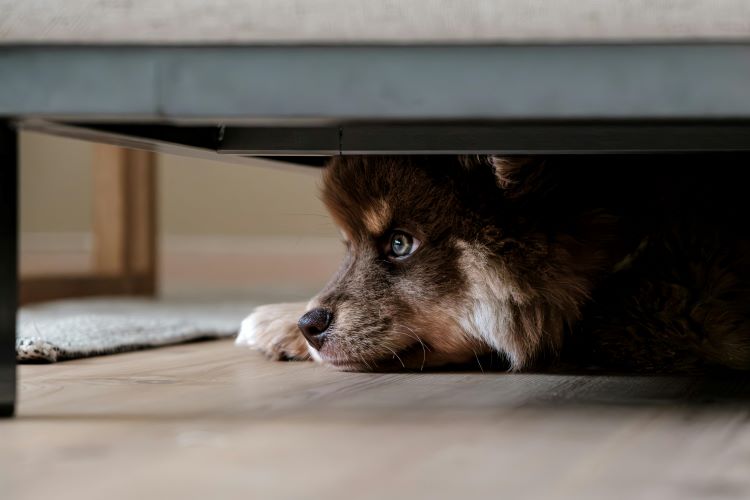Ready to help treat your pet to a healthy life?
How to Ease Separation Anxiety in Dogs
By : Brianna Gunter & Trupanion Staff | Updated Aug 19, 2025

Does your dog start whining or acting anxious right as you're about to leave the house? Or, maybe they closely follow you as you’re getting ready and bark as soon as you shut the door. Perhaps you’ve even gotten complaints from neighbors or have come home to a mess. Separation anxiety in dogs manifests itself in many different ways, but if any of that sounds familiar, your pup may be suffering from it. While it can feel frustrating and like you’ve already tried everything, rest assured that, A, you’re not alone, and, B, there are things you can do about it.
Separation anxiety in dogs is common, especially for pets that are in a new environment or who spend most of their time with their owner. But by taking the time to understand your dog’s specific separation anxiety triggers and their comfort needs, you can help your pet become more comfortable being alone.
By the way, this article is about dogs, but cats can suffer from separation anxiety too!
Are you misunderstanding your dog?
Separation anxiety in dogs is often misunderstood canine behavior. Many pet parents think it’s mere disobedience or acting out, when in fact it stems from deep emotional distress. When your dog barks nonstop, chews things up, or has accidents when left alone, they’re not being naughty — they’re just scared and feel overwhelmed. A lot of people think their dog is just acting out, so they respond with punishment, which only makes things worse. But the truth is that this isn’t a behavior problem but rather a mental health issue. Helping a dog with separation anxiety means building trust, keeping a consistent routine, and sometimes getting help from a trainer or vet to ease their stress.
Signs of separation anxiety in dogs
Dogs can be affected in different ways when stressed that their human is away. Some may act more aloof and fearful, while others may express their anxiety by being destructive. Generally speaking, however, you'll want to take note of any of the following indicators of separation anxiety:
- Whining and/or barking while you’re on your way out the door
- Closely following you around when you are home
- Chewing on items (especially things that smell like you)
- Urinating in the house even when they’re potty trained
- Complaints from neighbors about noise while you’re away
While these can also be signs of other issues, it’s important to consider separation anxiety as a possibility (especially if you’ve recently had a change in schedule or are away a lot). If you suspect any underlying health issues, however, or your dog’s behavior has suddenly changed despite your schedule staying the same, give their veterinarian a call.

7 tips for easing dog separation anxiety
There are many different methods you can try to ease your dog's separation anxiety. You may have to try a few different ones to find what works best for your pet.
1. Make you leaving no big deal
When leaving and returning home, for example, it's important to promote a very neutral and low-key experience for your dog. Ignore them completely for 15-20 minutes before leaving and 15-20 minutes after returning home. As tough as this may be to do, the truth is that petting them and giving lots of attention before leaving will only cause your pal to notice your absence that much more.
2. Desensitize your dog to leaving cues
You can also work to desensitize your pet to the signs that you’re leaving. For instance, try grabbing your keys, putting on your shoes, and getting your coat at various times of the day, walking around the house with them without leaving. If you normally don’t wear shoes while in your home, you may want to start wearing them for at least short periods of time while training your dog to be okay with you leaving. You may also want to consider putting them on early (an hour or so before you leave) just to help your pet calm down in their presence.
3. Practice leaving
Start practicing by leaving the house for very short periods of time. Be sure to keep the whole experience very low-key, as separation anxiety in pets can start with too much attention before leaving. Leave for 30 seconds and then return. Increase that time to 1 minute, 5 minutes, 15 minutes, etc. Vary the times and show your pet that regardless of how long you're gone, you will always return.
4. Use a crate
If your pet is comfortable with the crate (or even if they're not), crate training may be a good place to start to keep your pet in a comfortable environment where they won't have access to chew up your possessions. However, your dog should never be left cooped up in a crate for hours on end. This is just for when you’re running errands or other short ventures away from home.
5. Stay consistent
No matter what methods you try, being consistent is key. Just like other forms of training, your dog will not become comfortable being home alone if you don’t keep up with your methods or give in to your pet’s behavior.

6. Prep for while you’re away
It’s not just about practicing being away from your dog and getting them used to you leaving. Separation anxiety in dogs can also be prompted by your pet not having everything they need while alone or being in a stressful environment. Just like with training them to be okay with you leaving, there are various things you can do to help in this area:
- Exercise your dog before leaving.
- Make sure your dog goes to the bathroom before you’re away for hours.
- Consider leaving the TV on or having some music play for your pet while you’re gone.
- Leave a couple toys out.
- Make sure your pet’s water bowl is full of fresh water.
- Feed your pet before you go.
- Consider an automatic pet feeder to avoid any disruptions to their schedule.
7. Consider alternatives to leaving your dog at home
For some dogs, being left home alone just isn’t the best option. This can be true for young puppies, older dogs who are accustomed to humans always being around, older dogs who recently became solo pets due to the death of another pet, dogs with certain health concerns, and dogs who get highly destructive or put themselves at risk when left home alone. For these dogs, it’s wise to consider alternatives to leaving them at home alone — not just to help beat separation anxiety, but for their own safety.
For these pets, viable alternatives can include doggy daycare or a daytime pet sitter. Some dogs also do well just being checked up on regularly throughout the day, so scheduling a dog walker or a neighbor to stop in while you’re gone could be a good idea. It’s also wise to talk with your pet’s veterinarian about their behavior to ask for recommendations (and of course make sure your pet isn’t suffering from any underlying health conditions).
Last but not least, sometimes it takes professional help. If you are still having trouble with separation anxiety, consider enlisting the help of a dog trainer with expertise in this area.
